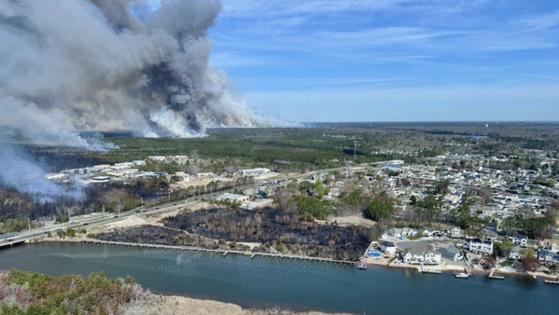NJ's biggest fire in more than a decade started in area known for illegal bonfires
Published in News & Features
For years, Damon Noe witnessed abuses within the vast Forked River Mountains Wilderness Area as partyers trashed terrain, off-road-vehicle riders tore through delicate landscapes, and young people ignited towering bonfires.
The destructive acts persisted even after barricades were installed to shield thousands of acres of environmentally sensitive land, said Noe, critical lands manager for the Nature Conservancy.
"There's a spot where a fire tower stood before it was torn down long ago," Noe said. "It left behind a mound that became a magnet for bonfires. The ground would be littered with thousands of shattered bottles, heaps of ash, and freshly cut trees, all tossed into the flames."
Fortunately those fires had never roared unchecked into the depths of the pines.
Until now.
15,000 acres burned
The illegal bonfire that ignited April 22 at Forked River Mountains has become New Jersey's worst wildfire since at least 2012, according to data supplied by the state Department of Environmental Protection (DEP).
The Jones Road Wildfire scorched 15,300 acres and is still burning, though it was 80% contained as of Thursday.
The fire destroyed a commercial building, vehicles, and also some of the state's prized Atlantic white cedar forests that officials have been trying to preserve and regenerate.
It burned through areas dense with wildlife.
Officials have accused Joseph Kling, 19, of Waretown of setting the fire. He has been charged with arson and aggravated arson by the Ocean County Prosecutor's Office. Kling set several wooden pallets ablaze and left them to burn unattended, the prosecutor's office said.
The Atlantic City Press reported Thursday that Kling told investigators that he was part of a group attending a bonfire before the fire broke out but that he was not the one who ignited it, according to his lawyer Joseph Compitello. The lawyer told the newspaper that Kling identified the person he believes is responsible for setting the fire.
People vs. the Pinelands
Officials acknowledge that misuse of the state's vast Pinelands region is an ongoing issue.
In New Jersey, 99% of all forest fires are caused by people, either through carelessness or intentionally. As the state's population grows just outside the Pinelands borders, the potential for fires has increased.
Hundreds of miles of unmarked sand road provide easy access to the Pinelands. Dense forests make it easy for people driving or venturing into environmentally sensitive areas to avoid detection. Development on the fringes of the Pinelands brings more people into contact with the woods.
Ocean County Sheriff Michael Mastronardy said New Jersey State Police, Ocean County, and the state Department of Environmental Protection State Parks Police all patrol the forests, including weekend patrols with aerial support.
But the size of the Pinelands, which span large state, county and private tracts, makes patrols challenging.
"Different areas become troublesome," Mastronardy said.
In an average year, 1,500 wildfires burn through 7,000 acres of the state's forests. But this year has been well above normal. Already, major wildfires have burned through nearly 20,000 acres, according to DEP data, some of that attributable to drought and high winds.
'Huge piece of open space'
Noe said it has long been difficult to keep tabs on all those using the property.
In all, the Forked River Mountains area actually spans about 20,000 acres covered by pitch pine and scrub oak. It also contains Atlantic white cedar, black gum and maple swamps and forests. The area provides habitat for rare and threatened wildlife, such as swamp pink plants and the northern pine snake.
"It's a huge piece of open space in the middle of not very populated area, with big sand roads," Noe said.
Fire roads, which are legal to drive on, run through the woods. And there are hiking and mountain biking trails. Noe noted that the preserve drew plenty of respectful motorists, hikers, birders and other users.
He said things changed, especially as social media has allowed people to quickly organize big vehicle rallies or parties.
Noe said some people ignored signs that designated certain areas sensitive or off-limits. He recalled one revelry spot where staff collected 80 bags of trash and glass.
Noe said motorists drove "willy nilly all over the woods," sometimes in trucks with giant tires that tore up muddy areas, leaving ruts in landscape that contained rare plants. It became like an "arms race" to keep up, he said.
"The preserve suffers when they light giant fires and leave the beach littered with glass," Noe said. "It takes away from the beauty of the area. And it wears on you as a manager."
©2025 The Philadelphia Inquirer, LLC. Visit at inquirer.com. Distributed by Tribune Content Agency, LLC.







Comments